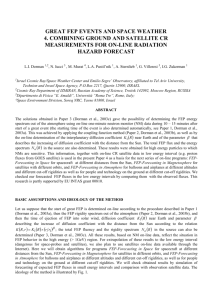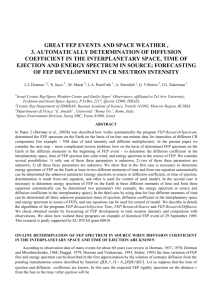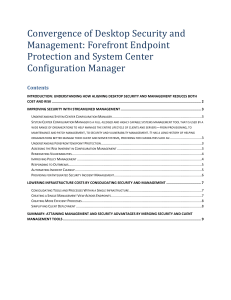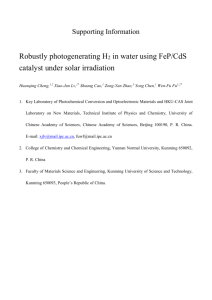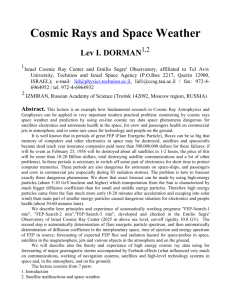2. automatically determination of solar energetic particle spectrum
advertisement
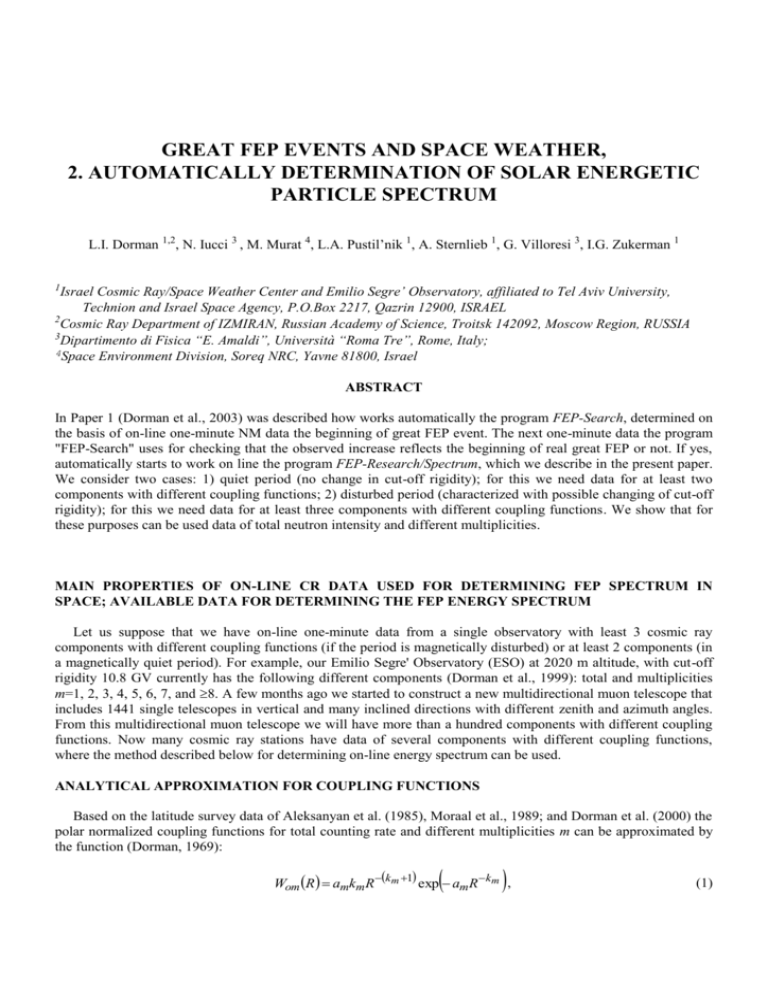
GREAT FEP EVENTS AND SPACE WEATHER, 2. AUTOMATICALLY DETERMINATION OF SOLAR ENERGETIC PARTICLE SPECTRUM L.I. Dorman 1,2, N. Iucci 3 , M. Murat 4, L.A. Pustil’nik 1, A. Sternlieb 1, G. Villoresi 3, I.G. Zukerman 1 1 Israel Cosmic Ray/Space Weather Center and Emilio Segre’ Observatory, affiliated to Tel Aviv University, Technion and Israel Space Agency, P.O.Box 2217, Qazrin 12900, ISRAEL 2 Cosmic Ray Department of IZMIRAN, Russian Academy of Science, Troitsk 142092, Moscow Region, RUSSIA 3 Dipartimento di Fisica “E. Amaldi”, Università “Roma Tre”, Rome, Italy; 4Space Environment Division, Soreq NRC, Yavne 81800, Israel ABSTRACT In Paper 1 (Dorman et al., 2003) was described how works automatically the program FEP-Search, determined on the basis of on-line one-minute NM data the beginning of great FEP event. The next one-minute data the program "FEP-Search" uses for checking that the observed increase reflects the beginning of real great FEP or not. If yes, automatically starts to work on line the program FEP-Research/Spectrum, which we describe in the present paper. We consider two cases: 1) quiet period (no change in cut-off rigidity); for this we need data for at least two components with different coupling functions; 2) disturbed period (characterized with possible changing of cut-off rigidity); for this we need data for at least three components with different coupling functions. We show that for these purposes can be used data of total neutron intensity and different multiplicities. MAIN PROPERTIES OF ON-LINE CR DATA USED FOR DETERMINING FEP SPECTRUM IN SPACE; AVAILABLE DATA FOR DETERMINING THE FEP ENERGY SPECTRUM Let us suppose that we have on-line one-minute data from a single observatory with least 3 cosmic ray components with different coupling functions (if the period is magnetically disturbed) or at least 2 components (in a magnetically quiet period). For example, our Emilio Segre' Observatory (ESO) at 2020 m altitude, with cut-off rigidity 10.8 GV currently has the following different components (Dorman et al., 1999): total and multiplicities m=1, 2, 3, 4, 5, 6, 7, and 8. A few months ago we started to construct a new multidirectional muon telescope that includes 1441 single telescopes in vertical and many inclined directions with different zenith and azimuth angles. From this multidirectional muon telescope we will have more than a hundred components with different coupling functions. Now many cosmic ray stations have data of several components with different coupling functions, where the method described below for determining on-line energy spectrum can be used. ANALYTICAL APPROXIMATION FOR COUPLING FUNCTIONS Based on the latitude survey data of Aleksanyan et al. (1985), Moraal et al., 1989; and Dorman et al. (2000) the polar normalized coupling functions for total counting rate and different multiplicities m can be approximated by the function (Dorman, 1969): Wom R amkm Rkm 1 exp am Rkm , (1) where m = tot, 1, 2, 3, 4, 5, 6, 7, 8. Polar coupling functions for muon telescopes with different zenith angles can be approximated by the same type of functions determined only by two parameters am and k m . Let us note that functions described by Eq. 1 are normalized: Wom R dR 1 at any values of am and k m . The 0 normalized coupling functions for point with cut-off rigidity Rc , will be Wm Rc , R amkm Rkm 1 1 am Rckm 1 exp am R km , if R Rc , and Wm Rc , R 0 , if R Rc (2) THE FIRST APPROXIMATIONS OF THE FEP ENERGY SPECTRUM In the first approximation the spectrum of primary variation of FEP event can be described by the function DR Do R bR , (3) where DR DR, t Do R , Do R is the differential spectrum of galactic cosmic rays before the FEP event and D R, t is the spectrum at a later time t. In Eq. 3 parameters b and depend on t. Approximation (3) can be used for describing a limited interval of energies in the sensitivity range detected by the various components. ON-LINE DETERMINING OF THE FEP SPECTRUM FROM DATA OF SINGLE OBSERVATORY The Case of Magnetically Quiet Periods In this case the observed variation I m Rc I m Rc I mo Rc in some component m can be described in the first approximation by function Fm Rc , : I m Rc bFm Rc , (4) where m = tot, 1, 2, 3, 4, 5, 6, 7, 8 for neutron monitor data (but can denote also the data obtained by muon telescopes at different zenith angles and data from satellites), and Fm Rc , am k m 1 exp am Rc k m 1 k 1 R m exp a mR km dR (5) Rc is a known function. Let us compare data for two components m and n. According to Eq. 4 we obtain I m Rc I n Rc mn Rc , , where mn Rc , Fm Rc , Fn Rc , (6) as calculated using Eq. 5. Comparison of experimental results with function mn Rc , according to Eq. 6 gives the value of , and then from Eq. 4 the value of the parameter b. The observed FEP increase for different components allows the determination of parameters b and for the FEP event beyond the Earth's magnetosphere. The Case of Magnetically Disturbed Periods For magnetically disturbed periods the observed cosmic ray variation instead of Eq. 4 will be described by I k Rc RcWk Rc , Rc bFk Rc , , (7) where Rc is the change of cut-off rigidity due to change of the Earth's magnetic field, and Wk Rc , Rc is determined according to Eq. 2 at R Rc : Wm Rc , Rc amkm Rckm 1 1 am Rc km 1 exp am Rc km . (8) Now for the first approximation of the FEP energy spectrum we have unknown variables , b, Rc , and for their determination we need data from at least 3 different components k=l, m, n in Eq. 7. In accordance with the spectrographic method (Dorman, 1975) let us introduce the function lmn Rc , Wl Rc , Rc Fm Rc , Wm Rc , Rc Fl Rc , , Wm Rc , Rc Fn Rc , Wn Rc , Rc Fm Rc , (9) Wl Rc , Rc I m Rc Wm Rc , Rc I l Rc , Wm Rc , Rc I n Rc Wn Rc , Rc I m Rc (10) Then from equation lmn Rc , the value of can be determined. Using the found value of , for each time t, we determine Rc b Fl Rc , I m Rc Fm Rc , I l Rc , Fm Rc , I n Rc Fn Rc , I m Rc (11) Wl Rc , Rc I m Rc Wm Rc , Rc I l Rc , Wl Rc , Rc Fm Rc , Wm Rc , Rc Fl Rc , (12) So, in magnetically disturbed periods the observed FEP increase for different components also allows the determination of parameters and b, for the FEP spectrum beyond the Earth's magnetosphere, and Rc , giving information on the magnetospheric ring currents. CALCULATION OF SPECIAL FUNCTIONS USED IN Eq. 4 12 Let us calculate the special functions what we used above, in Eq. 4 12. For this we need in the first to determine coupling functions. Determining of Coupling Functions by Latitude Survey Data The coefficients a m and k m for the coupling functions in Eq. 1, 2 and 8 were determined from a latitude survey by Aleksanyan et al. (1985) and they are in good agreement with theoretical calculations of Dorman and Yanke (1981), and Dorman et al. (1981). Improved coefficients were determined on the basis of the recent Italian expedition to Antarctica (Dorman et al., 2000). The dependences of a m and k m from the average station pressure h (in bar) and solar activity level (characterized by the logarithm of CR intensity; we used monthly averaged intensities from the Climax, USA neutron monitor as ln I Cl ) can be approximated by the functions: (13) ktot 0.180 h 2 0.849 h 0.750 ln I Cl 1.4402 h 2 6.403h 3.698 , (14) atot 2.915 h 2 2.237 h 8.654 ln I Cl 24.58h 2 19.46 h 81.23 , am atot 0.987 m 2 0.2246 m 6.913 9.781 (15) k m ktot 0.0808 m 1.8186 1.940 . (16) Calculation of Integrals Fm Rc , The integrals Fm Rc , determined by Eq. 5 are calculated by using Eq. 13 16 for values of from -1 to +7, for different average station air pressure h, cut-off rigidities Rc , and different levels of solar activity characterized by the Climax NM intensity (values ln I Cl ) according to k F m R c, a m k m 1 exp a m Rc m 1 k n n nk 1 Rc m 1 am Rc m n!n 1k m . n 0 (17) Results of calculations of Eq. 17 at different values of from -1 to +7 show that integrals Fm Rc , can be approximated, with correlation coefficients between 0.993 and 0.996, by the function F m Rc , , h, ln ICl Am Rc , h, ln ICl exp Bm Rc , h, ln ICl . (18) Calculation of Functions mn Rc , , and lmn Rc , Functions mn Rc , determined by Eq. 6 by using Eq. 18 becomes mn Rc , Fm Rc , Fn Rc , Am An exp Bm Bn , (19) and Eq. 9 becomes lmn Rc , Wl Rc , Rc Am exp Bm Wm Rc , Rc Al exp Bl , Wm Rc , Rc An exp Bn Wn Rc , Rc Am exp Bm (20) Example of Determination of the FEP Energy Spectrum in Quite Period From comparison of Eq. 18 and Eq. 6 follows that the spectral index will be ln Am An ln I m Rc I n Rc Bm Bn (21) Then from Eq. 4 we determine b I m Rc Am exp Bm ln Am An ln I m Rc I n Rc Bm Bn 1 . (22) So for magnetically quite period the inverse problem can be solved on-line for each one-minute data interval during the rising phase. For magnetically disturbed times the inverse problem can also be solved automatically in real-time, using the special function described in Eq. 20 (for observations by at least three components at one observatory). SPECIAL PROGRAM FOR ON-LINE DETERMINING OF ENERGY SPECTRUM FOR THE CASE OF SINGLE OBSERVATORY IN QUITE PERIOD Let us consider data from neutron monitor with independent registration of total flux and 7 multiplicities as input flux of data as vector I m i , where i –is number of time registration index, m- number of channel ( m 0 – total flux, m 1 7 different multiplicities). For estimation of the statistical properties of input flux we calculate mean and standard deviation for each channel I m i and m i on the 1-hour interval, preceded to itime moment on 1-hour. During next step we calculate vector of relative deviations : I m i I m i I m i I m i (23) and correspondent standard deviation I m i . On the basis of deviation’s vector I m i we calculate matrix Rmn i I m i I n i (24) of ratios deviations for different energetic channels m, n at the time moment i and its standard deviation Rmn i . On the basis of Eq. 21 and Eq. 22 by using Eq. 23 we calculate matrix of the spectral slope mn i , matrix of amplitude bmn i and estimations of correspondent standard deviations mn i and bmn i . For conversation of matrix output of estimated slope mn i to the scalar’s form i we use estimation of the average values taking into account the correspondent weights W of the individual values mn i determined by the correspondent standard deviations m, n W mn i mn i 2 mn i 2 that i mn m, n 1 , i W mn i . (25) (26) The same we made for parameter bi : bi bmn i W bmn i . (27) m, n where 2 W bmn i bmn i 2 m, n bmn i 1 (28) By found values of i and bi can be determined FEP energy spectrum by using Eq. 3 for each moment of time: DR, i bi R i Do R (29) We checked this procedure on the basis of NM data on the Mt. Gran-Sasso in Italy for the event September 29, 1989. We used one minute data of total intensity and multiplicities from 1 to 7. The number of minutes is start from 10.00 UT at September 29, 1989. Results are shown in Fig. 1. Upper limit of indexes m, n we choose about 3÷4, since for higher multiplicities accuracy level decreases fast and we may decrease confidence of the estimation. From the right side of Fig. 1 in the 3 graphical windows it may be seen observed total intensity variation (the top window), values of i calculated according to Eq. 26 on the basis of matrix data mn i (the middle window), and estimated amplitude bi calculated according to Eq. 27 on the basis of matrix data bmn i (the bottom window). Horizon axes is time started from 10.00 UT at September 29, each point is 1 minute data, time axes is divided in three 1-hour blocks. In the left side of Fig. 1, in four windows are situated for output of table data in ASCII form. There is output relative amplitude in the top window; output ratio of relative amplitudes for total and first multiplicity channels; flux at the choose moment for analysis (in this output – moment of the maximum) and estimation of the gamma matrix (spectral slope in this moment of time) for different combination m,n; matrix of estimations for output amplitude of FEP. Fig. 1. Simulation of real-time monitoring and analysis of FEP on example of event 29 September 1989. Data of 3NM-64 on Mt. Gran-Sasso. Details in text. CONCLUSION In this paper we show that by ground data of single CR Observatory on the basis of continue registration in oneminute scale of several components with different coupling functions is possible to calculate on-line FEP spectrum out of magnetosphere. Corresponding formulas and program are presented. ACKNOWLEDGEMENTS: This research is partly supported by EU INTAS Grant 00810. REFERENCES Alexanyan T.M., L.I. Dorman, V.G. Yanke, and V.K. Korotkov, Proc. 19-th ICRC, La Jolla, 5, 300-303, 1985. Dorman L.I., Proc. 11-th ICRC, Budapest, Vol. of Invited Papers and Rapporteur Talks, 381-444, 1969. Dorman L.I., Variations of Galactic Cosmic Rays, Moscow State University Press, Moscow, 1975. Dorman L.I. et al., Proc. 26-th ICRC, Salt Lake City, 7, 425-428, 1999. Dorman L.I., G. Villoresi, N. Iucci, M. Parisi, N.G. Ptitsyna, J. Geophys. Res.- Space Phys. 105, 21047, 2000 Dorman L.I. and V.G. Yanke, Proc. 17-th ICRC, Paris, 4, 326, 1981. Dorman L.I., V.G. Yanke and V.K. Korotkov, Proc. 17-th ICRC, Paris, 4, 330, 1981. Moraal H., M.S. Potgieter, P.H. Stoker, and A.J. Van der Walt, J. Geophys. Res., 94, No. A2, 1459, 1989. E-mail address of Lev I. Dorman: lid@physics.technion.ac.il, lid1@ccsg.tau.ac.il Manuscript received ; revised , accepted
